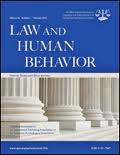 The SSPI significantly added to the predictive accuracy of the STABLE-2007 in terms of deviant sexual interest in children while it did not bolster the Static-99R or Static-2002R. This is the bottom line of a recently published article in Law and Human Behavior. Below is a summary of the research and findings as well as a translation of this research into practice.
The SSPI significantly added to the predictive accuracy of the STABLE-2007 in terms of deviant sexual interest in children while it did not bolster the Static-99R or Static-2002R. This is the bottom line of a recently published article in Law and Human Behavior. Below is a summary of the research and findings as well as a translation of this research into practice.
Featured Article | Law and Human Behavior | 2015, Vol. 39, No. 1, 35-43
 The Screening Scale for Pedophilic Interests (SSPI): Construct, Predictive, and Incremental Validity
The Screening Scale for Pedophilic Interests (SSPI): Construct, Predictive, and Incremental Validity
Author
Leslie Helmus, Forensic Assessment Group, Ottawa, Ontario, Canada
Caoilte Ó Ciardha, University of Kent
Michael C. Seto, Royal Ottawa Health Care Group, Brockville, Ontario, Canada
Abstract
This study of 410 adult male sex offenders against children, using data from the Dynamic Supervision Project (Hanson, Harris, Scott, & Helmus, 2007), examined the construct, predictive, and incremental validity of the Screening Scale for Pedophilic Interests (SSPI; Seto & Lalumière, 2001), a brief proxy measure of phallometrically assessed sexual response to children that is based on sexual victim characteristics. As predicted, the SSPI was significantly related to the Deviant Sexual Interests item on the STABLE-2007 (Hanson et al., 2007), a dynamic risk measure encompassing multiple domains, and with the Deviant Sexual Interests item from its predecessor, the STABLE-2000 (Hanson et al., 2007). The SSPI was unrelated (or more weakly related) to items measuring general antisociality. In addition, the SSPI significantly predicted sexual recidivism, defined as new charges or convictions for sexual offenses, and a broader sexual recidivism outcome that included breaches of community supervision conditions that might involve sexually motivated behavior (e.g., being in the presence of children unsupervised). The SSPI did not add to the predictive accuracy of 2 actuarial risk measures, the Static-99R and Static-200R (Helmus, Thornton, Hanson, & Babchishin, 2012), but it did add to the predictive accuracy of the STABLE-2007. Additional analyses suggest the SSPI can serve as a substitute for the STABLE-2007 Deviant Sexual Interests item, if necessary (e.g., in archival research), when assessing sexual offenders against children.
Keywords
deviant sexual interests, sexual offenders, prediction, recidivism, risk assessment
Summary of the Research
The Screening Scale for Pedophilic Interests (SSPI) is a risk assessment measure of deviant sexual interest in children. The measure provides timely and direct assessment based on criminal history information without requiring detailed file reviews, interviews with the offender, or specialized testing. Total SSPI scores range between 0 and 5, with higher scores indicating a greater likelihood of sexual interest in children. It aims to be a valid counterpart to the Static-99R, Static-2002R, and STABLE-2007.
This study examined the construct and predictive validity of the SSPI in a sample of 410 adult male sexual offenders against children.
Construct Validity
The SSPI was compared to similar sexual violence risk assessment tools for its construct validity: (1) Static-99R, (2) Static-2002R, (3) STABLE-2007, and (4) STABLE-2000 Deviant Sexual Interest Item. The SSPI differs mostly from its counterparts with its emphasis on sexual offenses against children fourteen years or younger. Supervising officers provided their assessments from the four measures as part of the study as well as descriptive data regarding the offenders’ victim history.
“Total scores on the SSPI were moderately related to the STABLE-2000 Deviant Sexual Interests item and strongly related to the STABLE-2007 Deviant Sexual Interests item. Static-2002R was very strongly related to both complete SSPI scores and the approximated SSPI score” (p. 39).
Discriminant Validity
The SSPI was examined for discriminant validity in terms of antisocial behavior and general criminality. “Both the complete and approximated SSPI scores were unrelated to nonsexual violence (either as part of their current sex offense or a prior conviction), prior sentencing dates (on Static-99R), cooperation with supervision, impulsive acts, and any conviction for break and enter” (p. 39). Conversely, both SSPI scores were significantly related to prior sentencing occasions for any type of offense, poor cognitive problem-solving, and negative emotionality/hostility. “Although some of these correlations were significant, the highest correlation was still lower than the relationship between SSPI and the STABLE-2007 Deviant Sexual Interests item, and substantially lower than the other potential measures of deviant sexual interest” (p. 39)
The total scores for the SSPI were not statistically significant for nonsexually violence and nonviolent recidivism. Overall, the results show that the SSPI is more related to measurements of deviant sexual interests than to broadly defined criminality.
Predictive Validity
“SSPI was examined for predictive validity in terms of sexual recidivism and sexual recidivism with breaches. The complete SSPI total score was significantly correlated to both sexual recidivism and sexual recidivism with breaches” (p. 39).
Individual SSPI items did not show a strong relationship with sexual recidivism; the strongest individual item was having two or more child victims. “Similarly, the other indicators of deviant sexual interests showed small relationships with the outcomes. Both outcomes were significantly predicted by the unrelated victim item of Static-99R, the Deviant Sexual Interests subscale of the Static-2002R, and the Deviant Sexual Interests item of the STABLE-2007 (but not the STABLE- 2000). The Deviant Sexual Interest subscale of Static-2002R had fairly comparable predictive accuracy to the SSPI, whereas the Deviant Sexual Interests item of STABLE-2007 had slightly lower accuracy than the SSPI and Static-2002R subscale” (p. 40).
Translating Research into Practice
In terms of incremental validity, the SSPI did add to the STABLE-2007 for prediction of sexual recidivism. A greater emphasis on factors for deviant sexual interest towards children could positively affect the STABLE-2007 scale. For practical applications, this research suggests that by using both measures, predictive accuracy could be improved for sexual recidivism. Conversely, the SSPI did not significantly add to the Static-99R or the Static-2002R. In this study, the latter two assessment tools were found to adequately account for deviant sexual interest in children.
The Static-99R and Static-2002R have better predictive accuracy when it comes to recidivism most likely due to having a wider breadth of contributing variables. The SSPI is less suitable to predict recidivism rates for this population because recidivism is impacted by more factors than just sexual interest in children.
Based on these research results, “the SSPI could be a reasonable substitute for the STABLE-2007 Deviant Sexual Interests item if insufficient information was available to score the STABLE-2007 item as intended” (p. 42). This is not meant to formally substitute risk assessments in applied settings but to encourage more research for the SSPI.
Overall, the SSPI should be used as a brief assessment tool to quickly acquire information for sexual risk assessment towards young children. The research has expressed benefits for using the SSPI with other tools like the STABLE-2007 but it is not the only risk assessment tool that captures individual characteristics of sexual deviance towards children.
Other Interesting Tidbits for Researchers and Clinicians
In terms of sexual recidivism, “antisociality indicators play an important role as well, as reflected in variables such as younger offender age and prior criminal history. Although future refinement of the SSPI may improve its predictive ability somewhat, this will always be bounded by the absolute contribution of deviant interests to future reoffending” (p. 42).
Join the Discussion
As always, please join the discussion below if you have thoughts or comments to add!







